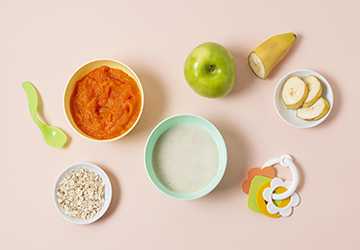The journey of being a mom is filled with countless blessings, and one of the most exciting and sometimes challenging ones is the hard items introduced to your baby. Transitioning from exclusive milk or formula to a wider variety of nutrients and tastes is a significant step in their development. However, it can also be a confusing time for parents, with questions about when to start, what foods to offer, and how to do it safely. This article will explore every aspect of transitioning your little one to having hard items, making the process smooth and enjoyable for you and your little one.

Before pushing your little one to have hard items, it's vital to discern the symptoms of know-how. While the timing may vary, most little ones are primed for hard items between four to five months. Look for cues such as steady head control, sitting with minimal support, and an interest in food, like watching others eat or reaching for food.
Giving hard items to your little ones should be approached with patience and simplicity. Begin with single-ingredient purees or mashed foods like bananas, avocados, or cooked sweet potatoes. These options are not harsh on your little one’s gastrointestinal tract and provide a smooth change to harsh items. Starting with chewable items allows your little one to acclimate to new aromas gradually. This approach reduces the risk of digestive discomfort and helps build a foundation for healthy eating habits. Remember to offer each item individually, waiting a few days before introducing another to monitor for any symptoms of hypersensitivity.
Each baby follows a unique timeline, making it essential to approach the introduction of solids with flexibility. Tune into your baby's cues and allow them to guide the process. If your little one shows enthusiasm and curiosity towards new foods, seize the opportunity to introduce them. Conversely, if they display hesitation or disinterest, refrain from pressuring them. Offer foods gradually, respecting their pace, and exercise patience as they navigate this new experience. Remember, it's normal for babies to adjust, so stay attentive and supportive throughout their exploration of solid foods. Following your baby's cues and offering gentle encouragement can foster a positive and enjoyable journey into the world of eating solids.
As your baby becomes accustomed to consuming simple purees, it's the opportune moment to broaden their culinary horizons. Introduce diverse foods encompassing fruits, vegetables, grains, and proteins, guaranteeing a comprehensive nutrient intake crucial for their growth and development. Encourage exploration by offering various flavors and textures, igniting their curiosity, and expanding their palate. Embrace experimentation, as every new taste experience contributes to their evolving preferences. Exposing your baby to various foods early on lays the foundation for healthy eating habits and a lifelong appreciation for diverse cuisines. This adventurous approach to feeding fosters physical well-being and cultivates a positive relationship with food from an early age.
Make mealtime an exciting adventure for your baby by infusing creativity into how you serve their food. Bright and colorful plates and fun-shaped utensils can captivate their attention and make the experience more enjoyable. Consider arranging their food into playful designs or patterns to stimulate their curiosity and appetite. Encourage hands-on exploration by allowing your baby to touch and feel their food, even if it means embracing the inevitable mess. By involving them in the process, you foster a positive association with food and promote sensory development and fine motor skills. Ultimately, creating a schedule and atmosphere sets the stage for your little one to develop lifelong habits with zest and happiness.

Transitioning your baby to solid foods can be gradual and occasionally messy, requiring patience and persistence. It's normal for your little one to reject certain foods or create a mess—it's all part of the learning process. Instead of feeling discouraged, view these moments as opportunities for exploration and growth. Continuously offer diverse foods and flavors, encouraging your baby to develop its palate. Over time, they'll become more comfortable and adventurous with eating solids, expanding their culinary horizons, and laying the foundation for healthy eating habits. So, embrace the mess and enjoy watching your baby discover the joys of food.
As your child grows accustomed to eating soups, gradually advancing their item’s structure and appearance is beneficial. Begin by introducing mashed foods with small, soft lumps or finely chopped pieces, which aid in developing their chewing skills. This incremental transition allows your baby to become accustomed to the sensation of different textures in their mouth, preparing them for more solid foods in the future. By gradually increasing the complexity of textures, you're providing valuable opportunities for your baby to refine their oral motor skills and adapt to a wider variety of food consistencies. This approach fosters a smooth and successful transition from purees to more solid foods, ensuring your baby's continued enjoyment and development at mealtime.
When introducing new foods to your baby, you must watch for any signs of allergies or sensitivities. Give them one thing at a time and wait a few days before giving another to monitor for adverse reactions. Common allergenic foods like eggs, dairy, nuts, and seafood should be introduced with caution and under the guidance of your pediatricians, especially if there's a family history of allergies. If you notice any symptoms of hypersensitivity, such as rash, inflammation or aspiration, stop feeding the food immediately and consult your pediatrician.
In conclusion, giving your child hard items to eat is an exciting process of discovery and growth. By following these tips – starting slow, offering a variety of foods, making mealtime enjoyable, being patient and persistent, gradually increasing texture, and watching for allergies – you can help make this milestone a positive and rewarding experience for you and your little one. Remember, every baby is unique, so trust your instincts, go at your own pace, and enjoy this time of exploration and bonding. With love, patience, and a little messiness, you'll soon have a confident and adventurous eater.